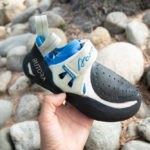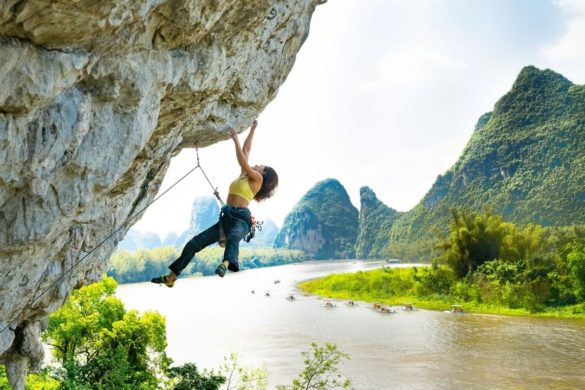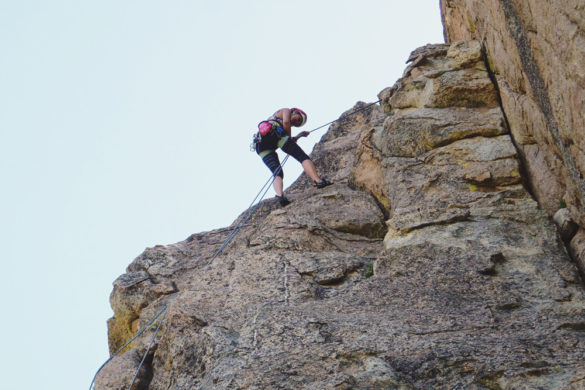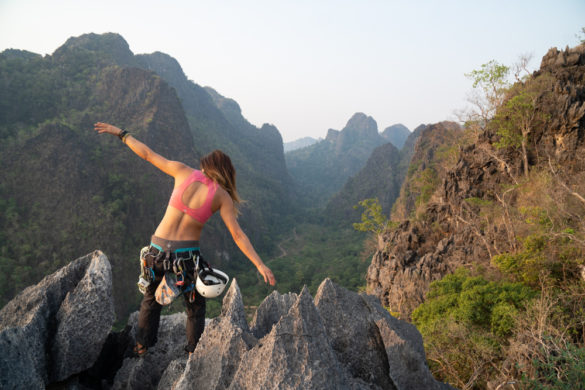Rock climbing in Ha Long Bay, Lan Ha Bay, and Cat Ba Island in Vietnam are the most picture-perfect places you’ll climb in your life. Limestone karsts tower over the emerald-colored water and together they create a magical landscape. In this area, you can go deep water soloing out in the bay, climb on the beaches, have crag days on Cat Ba Island, kayak, swim at the beach, go on a cruise ship, drink delicious coffee, visit a cave, hike at Cat Ba National Park and party with the SE Asia backpackers. With so many activities to do, this is the perfect vacation spot for those who enjoy outdoor adventures. Here is everything you need to know about climbing in Halong Bay, Lan Ha Bay, and Cat Ba Island.
Guide Contents
- Climbing on Cat Ba Island
- Deep Water Soloing in Ha Long Bay & Lan Ha Bay
- Best Time to Climb Ha Long Bay and Cat Ba Island
- Must-Do During Your Visit
- How Long Should You Stay
- Finding Climbing Partners on Cat Ba Island
- Guiding Companies
- Access to the Cat Ba Island Crags
- What is Cat Ba Town Like?
- I’m a Beginner, Should I Still Visit?
- Rest Day Activities
- Budget
- Getting Here
- Accommodation
- Getting Around
- Food On Cat Ba Island
- Rental Gear
- Guidebook
- SIM Card
- Working Here
- Buying Climbing Gear
- Visa for Vietnam
- Packing List
- Travel Tips For Vietnam
- What To Do in Vietnam Besides Climbing
- Other Climbing Destinations To Visit
Climbing on Cat Ba Island
Climbing on Cat Ba Island is easy and fun as the approaches are done with a scooter and a short walk. There are four main crags on the island: Butterfly Valley, Hidden Valley, Ben Beo, and Buddha Cave. There are many fun routes to climb on Cat Ba Island if you can climb in the 6’s and 7’s (5.10-5.12). All of the rocks are high-quality limestone but there is not a high concentration of world-class routes. While lacking in world-class routes, the weather, culture, and the adventure alone makes climbing on Cat Ba Island worth the visit. We advise that you combine your visit to Cat Ba Island with deep water soloing in Ha Long Bay/Lan Ha Bay and visiting other parts of Vietnam or Southeast Asia.

Stacy from the USA, climbing a tufa on “Very Tot” 6b at Butterfly Valley
We have heard mixed reviews that the grading is soft, but grading is always subjective. We found some of the 7’s to be soft and some of the 6’s to be hard. Regardless, don’t complain about the grade, have fun and appreciate that people have worked hard to make this place exist.
It’s mainly foreigners who climb here. English is the main spoken language for visiting climbers.
The crags are never crowded. Those who hate crowds would love climbing here.
Deep Water Soloing in Ha Long Bay & Lan Ha Bay
Deep water soloing in Ha Long Bay and Lan Ha Bay is the main reason why most climbers come to visit. Crags are spread out between Ha Long Bay and Lan Ha Bay and have fun routes for all levels. Those who are new to climbing will also find things to climb. Your guide can tailor your trip to accommodate climbers of all levels. Even if you’re scared to climb up high and jump down, the trip is still worth attending so that you can watch the more daring climbers. Plus, you’ll have a great day cruising the bay.

No ropes or gear, just climbing shoes and chalk. This is deep water soloing in Ha Long Bay. Climber: Joy from Switzerland.
This is what your deep water soloing experience will be like. First of all, check in advance with Cat Ba Climbing and Langur Adventures to see when the tides are good for deep water soloing. You won’t be able to deep water solo if the tides are low. You may need to climb/hangout on Cat Ba Island while waiting for the perfect day to go DWS. On the day of your DWS adventure, the guiding company will pick you up from your hotel and bring you to Ben Beo Harbor. From there you will board your boat to go into Lan Ha Bay. Your guide will give you safety guidelines before you climb. Once you have learned how to fall and how to be safe, you’ll be ready to climb on the wall. When it’s your turn, the boat driver will drive the boat close to the wall so that you climb on. When you’re on, your guide will spot you, so that your head does not hit the boat if you should fall off the wall. After the boat backs away from the wall, you’re clear to climb up. When you’ve reached the top of the route, you’ll need to jump down into the water and swim back towards the boat. You’ll rotate climbing on the wall with other climbers on your trip.

Why explore the bay on a cruise ship when you can climb on the bay? Climber: Milly from the UK. IG: @climbandtravel
Your tour may provide a delicious meal before or in the middle of your DWS adventure. If your tour includes food, your boat will drive you to a small cruise ship and you’ll eat your meal out in the bay!
Prices start at $33 USD for a half-day and up to $50 for a full day. Check with the guiding companies for the most up-to-date prices.
The guiding companies all speak English and the guides are usually climbers from all around the world.
If you don’t want to damage your climbing shoes, you can rent climbing shoes at the guiding shops for DWS.
Facts: Ha Long Bay is a UNESCO World Heritage Site and Ha Long means “descending dragon” in Vietnamese. People live in floating houses and villages in La Ha Bay. Some people even own dogs that live on the floating houses with them!

It’s always a good time out on the sea. Climber: Milly from the UK. IG: @climbandtravel
Best Time to Climb Ha Long Bay and Cat Ba Island
The best time to sport climb and deep water solo in Ha Long Bay, Lan Ha Bay, and Cat Ba Island is during Fall and Spring. The temperature is mild for sport climbing and the tides are ideal for deep water soloing.
Winter is the best time to visit if you just want to sport climb. The tides may not be optimal for DWS and the water may be cold.
Summer in this area is hot, humid and rains often, but during this time, the tides are high, which is perfect for deep water soloing. We enjoyed deep water soloing very much during June and July as the temperate out in the bay was mild and comfortable for taking a dip into the water. Even if it rains, the rock can dry quickly. You can technically climb on Cat Ba Island year-round as you can find shade during the summer and you can climb in the cave when it’s pouring outside. Be aware that Butterfly Valley does flood if the rain is intense, making the place inaccessible by foot.

Kimmie Tu from the USA, wondering how to best pinch on those tiny handholds on The Face. IG: @kimmie.tu
Must-Do During Your Visit
- Go deep water soloing.
- Climb on the Face. Those who are exceptional at Face climbing on tiny holds will find the routes here a bit soft.
- Multi-pitch on Tiger Beach, haven’t done so ourselves but we heard great things. New bolts were placed in 2018. You will need to hire a boat or guide to take you.
- Climb in Butterfly Valley.
- Climb at Hidden Valley. This crag has a lot of nice moderate climbs.
- Check out Buddha Cave. You get to climb in a cave and someone’s backyard.
- Try Vietnamese coffee at Like Coffee
- Drink 15,000 VND ($0.65 USD) beer on street with the locals
- Party with Southeast Asia’s backpackers
- Cruise around Ha Long Bay or Lan Ha Bay on a boat or explore with a kayak
- Learn about the history of Cat Ba Island and Ha Long Bay, this is a very historical destination.

Louisa was the best guide! She’s from the UK.
How Long Should You Stay
A minimum of one to two weeks is a good amount of time to experience everything in Ha Long Bay and Cat Ba Island. We climbed here for a total of six weeks and we had friends who stayed for a few months to a year to work as guides.
Finding Climbing Partners on Cat Ba Island
The easiest way to find a climbing partner would be to travel here with one. If that is not possible, here is what you can do:
- Join the Cat Ba Climbers Facebook group and find a partner there.
- Make a post on Traveling Rock Climbers Facebook group in advance to look for climbers.
- Go to the outdoor guide shops on Cat Ba Island and ask around. The guides working on the island may be looking for partners to climb with on their free days.
- Stay in the dorm at Cat Ba Climbing. You have to book in person or contact them.
- Hire a guide.
- Work as a guide and you’ll make friends with other guides who are keen to climb.

An endless sea of limestone karsts in Ha Long Bay.
Guiding Companies
There are two climbing guide companies on Cat Ba Island. Cat Ba Climbing manages Hidden Valley and Langur Adventures (used to be Asia Outdoors) manages Butterfly Valley. Be sure to check with both shops for the latest climbing information. You will need to visit the shops to obtain an access pass to the crags on the island.
Access to the Cat Ba Island Crags
Stop by the climbing shops to be tested for lead climbing safety for Hidden Valley and Butterfly Valley. Get your Hidden Valley access pass at Cat Ba Climbing and your Butterfly Valley safety check at Asia Outdoors (now Langurs Adventures). As of 2019, you’ll need to pay 10,000 VND ($0.43 USD) to the landowners of Butterfly Valley. The guide shops will check your skills in lead sport climbing and cleaning anchors. Climbing at Ben Beo doesn’t require a pass. Buddha Cave requires you to pay the landowner around 10,000 VND ($0.43 USD) as you will be climbing in his backyard.

Fun traverse problem for warming up and beginner climbers. Matching clothing is optional. Climbers: Josh from Bermuda, Joy from Switzerland, and Milly from the UK.
What is Cat Ba Town Like?
You’ll share this town with locals, Vietnamese tourists, outdoor guides, and Southeast Asia’s party-loving backpackers. While the town is relatively tame on weekdays, during the summer weekends, things can feel chaotic when the Vietnamese tourists visit. In town, you’ll find an abundance of restaurants that cater to every budget and taste. If you’re looking for a good party, you’ll find several bars and clubs which cater to both local and foreign tourists. If you’re noise sensitive, it’s best to avoid staying in the main area as the clubs bang loud music until late at night.
I’m a Beginner, Should I Still Visit?
Climbing at Ha Long Bay, Lan Ha Bay, and Cat Ba Island is great for beginners. Those will little to no experience can book a climbing trip with a guide. They’ll take you out to climb on Tiger Beach, Moody Beach, Butterfly Valley, or Hidden Valley. You can also try deep water soloing out in Lan Ha Bay. Inquire with Cat Ba Climbing and Langurs Adventures for full details.

Climbers from all around the world! Here we have Marwan from Jordan, Kimmie Tu from the USA, Ed from the UK, Pancho from Chile, and Lilan from Germany.
Rest Day Activities
- Visit Fort Cannon
- Hike at Cat Ba National Park
- Have a beach day
- Go for a drive around Cat Ba Island
- Go on a cruise ship around Ha Long Bay/Lan Ha Bay
- Visit a cave
Budget
Dorms range from $3-10 USD/night. Private rooms range from $11-40 USD/night. Prices will vary depending on the season and may increase on the weekends.
Meals are generally between 30,000-120,000 VND ($1.27-$5.17 USD).
Here is a sample budget:
$5 – Dorm
$1.26 – Breakfast
$0.86 – Coffee
$1.72 – Lunch
$2.58 – Dinner
$0.65 – Beer
$3 – Scooter rental
Total: $15.07 USD/day, $105.49 USD/week, $421.96/month
Your budget can be less or more than this, depending on how much you eat/drink and where you stay.
Other costs to consider:
- Deep water soloing trips with guiding companies ($33-50 USD)
- Petrol/gas for your scooter/motorcycle
- Bus to and from Cat Ba Island
- Climbing gear rental if you don’t have your own gear
- Travel insurance
- Medical bills if you get hurt. Getting medical treatment is relatively affordable in Asia.
- Mobile phone plans to stay connected

Nighttime at Ben Beo Harbor. The comparison between modern boats and old boats is very interesting.
Getting Here
- Fly to Noi Ban International Airport (HAN) in Hanoi, Vietnam.
- Hire a taxi or shuttle to go into the city. Beware of scammers trying to take you into the city for $20 USD. The ride into the city shouldn’t cost $20 USD. You can cross-check prices on Grab (ridesharing app) before hiring a taxi. You can also ask around for a shared shuttle/taxi into the city. If we can remember correctly, we found a shared shuttle for 60,000 VND ($2.58).
- Stay for a night in Hanoi. Staying in the Old Quarter is recommended for easy access to good hotels, transportation, good food, and nightlife.
- Tell your hotel to book you a shuttle to Cat Ba Island. All the hotels in Hanoi are well-connected with transportation companies to get you to where you need to go. The shuttle offers door-to-door service and ferry crossing. It’s the most efficient and best value above all other options (driving yourself, local bus, train, and flying). The price will vary but it seems like the estimated price is $12 USD. The journey will take between 3-5 hours depending on traffic.
OR
You can book your own bus through Good Morning Cat Ba or other bus companies that can be found by doing a quick google search of “Hanoi to Cat Ba Bus”.

We went for a swim in between climbing! Luckily no jellyfish stung us. Swimmers: Nicky from the UK and Kimmie Tu from the USA.
Accommodation
There are plenty of places to stay on Cat Ba Island. Be aware that during the summer it is high tourist season for Vietnamese people. You’ll see prices surge on the weekends. Booking in advance for the weekend rush during summer is highly recommended. Book your stay on Booking.com or upon arrival.
If you’re looking for a recommendation, we stayed at Sweet Potato Homestay and enjoyed our time there. It’s located on the outskirts of the busy town which means it is wonderfully quiet. They serve delicious pho (noodle soup) breakfast in the morning along with coffee. The homestay also doubles as a restaurant, which is great for days you feel like staying in. They offer scooter rentals, however, it’ll be cheaper if you rent one in town. The beds in the dorms are very comfortable and large, but the room is tiny and dark. The private rooms are basic and the beds are decent in terms of comfort. The laundry service is great here. The family who runs this place are very kind and provide excellent service.

THE BEST BOAT DRIVER EVER! He’s also a strong climber.
Getting Around
- Rent a scooter: You can rent a scooter on Cat Ba Island for a few US dollars a day. Prices depend on the rental shop and season. Try bargaining for a good deal if you will be renting long-term. You do not need an international driver’s license. You’ll need a scooter to drive to the crags. If you don’t know how to drive a scooter, ask the rental shop to show you. You can easily practice on the smaller streets in Cat Ba.
- Buy a motorcycle/scooter: You can buy your own motorcycle or scooter in Hanoi for around $150-$300 USD. If you’re lucky, you can buy a scooter/motorcycle from another foreigner on Cat Ba Island. Purchasing your own ride is ideal if you plan on staying Cat Ba long-term. Don’t forget to buy a good helmet too! It can save your life.
- Go with a guiding company: For deep water soloing, we highly recommend that you book a tour with a guiding company on Cat Ba Island. The guides know where all the crags are located and the boat drivers know what to do in order to keep you safe. We went deep water soloing three times with a guiding company and one without. The one time we went without a guiding company, the boat driver didn’t know where to go, he didn’t know English, and he didn’t know how to drive his boat for DWS. The experience was unsatisfactory.

High-quality limestone at Butterfly Valley! Here is Kimmie Tu struggling through the crux for Obama 101 7a/5.11d. Photo by Francisco Pena.
Scooter/motorcycle tips:
- Driving around Cat Ba is relatively easy compared to other cities in Vietnam.
- Always wear a helmet and take it easy. Locals and foreigners alike always get hurt when driving in Southeast Asia.
- Vietnamese drivers honk a lot, it’s done as a courtesy to announce they are nearby and the honking does not mean “F*CK YOU” like in western countries. Cultural differences are bizarre, right? Don’t be afraid to honk too, it can save your life. When it doubt just honk whenever you see any drivers close by (we are serious).
- Vietnamese drivers pay attention to the front and don’t look that much to the side and behind them. It’s your job to pay full attention at all times.
- Be careful of the lorries/trucks, they drive aggressively and we had many close-calls with them. Most of the close-calls were with Vietnamese drivers were outside of Cat Ba, but it doesn’t hurt to give lorries/trucks the right of way on Cat Ba.

You can buy fresh and delicious tropical fruits all around Vietnam. They are the perfect crag snack and dessert.
Food On Cat Ba Island
You won’t find amazing Vietnamese food as you would in Hanoi, but you can find good western-style food on Cat Ba Island. While the food won’t be the best food you’ve ever eaten in your life (go to Hanoi and HCM for this), the food quality is amazing for the price. You can find meals good meals for $1.30-$5 USD.
In terms of cleanliness, we didn’t find Cat Ba Island to be sanitary for food. At times our stomachs wouldn’t feel great but no one fell seriously ill. We were all able to stay strong and climb on. We didn’t try drinking the water and bought bottled water.
Here are our favorite places to eat:
- Yummy & Yummy 2 – Food is very affordable here but the food quality is just okay. This was our go-to spot for most meals. The owner Hien is very kind!
- Buddha Belly – Serves up amazing vegetarian food. It’s great even if you’re not a vegetarian.
- Mona – Serves up decent Vietnamese food and western food in a charming roof-top setting.
- Like Coffee – Best coffee in town and has a great breakfast and lunch menu. It has good WiFi for the area.
- The 25 Club – Serves up the best Vietnamese food in our opinion, but the food may not be sanitary. We still ate here. Prices are very fair.
- My Way – This place seems like the go-to spot for people who want western food.
- Vietnam Soul Food – We haven’t tried the food here but our friends have said great things.

Francisco Pena working out the crux on Licensed to Climb 7a+ on the Face in Ha Long Bay.
Rental Gear
If you need to rent gear, you can rent at the guide shops in town.
Guidebook
Check with the climbing shops to see if they are still selling the guidebook. Cat Ba Climbing may still have some in print and Langurs Adventures expects to resume printing in November 2019. If the book is not available, the guiding shops will let you take photos of their guidebook. Mountain Project has many of the routes listed in its database. While MP doesn’t exactly help you identify where the lines are, it’s a decent source to learn about the area and plan which routes you want to climb.
SIM Card
Get one at the airport. It’s affordable and they offer great deals. We had Vodafone and Viettel and were pleased with the coverage. You can buy top-ups at many shops around Vietnam.

A crazy downpour of rain disrupted our DWS trip, but we made the most of it by going for a swim in the bay. Check out the floating house in the background!
Working Here
There are paid and volunteer positions available with establishments around the island. If volunteering, you will be compensated with free accommodation and food. As of 2018, we met foreigners working at Mona, Langurs Adventures, Cat Ba Climbing, and Sweet Potato Homestay. Send them an email for further information about volunteering and working.
Buying Climbing Gear
If you need to buy climbing gear, you can go shopping at Viet Climb in Hanoi. Note that climbing gear in Asia costs more than purchasing in Western countries. As of 2018, you cannot buy climbing gear on Cat Ba Island. If you want good shoes, it’s best to travel to Vietnam with a few pairs as the selection in Vietnam is lacking.

Milly working out the moves for the 7a climb in her head.
Visa for Vietnam
For most foreigners, you will be required to obtain a visa BEFORE arriving in Vietnam. If you’re staying for only 30 days you can apply for an E-Visa for $25 USD. If you’re staying longer than 30 days, you can obtain a longer visa through third party agencies. A quick Google search “visa for Vietnam” will provide you with many agencies to choose from. Note: the third-party visa agency websites may look like a scam, but they are legitimate and provide quick turnaround times.
You can get a visa on arrival, however, you may get unlucky and be charged an outrageous fee. My friend had to pay a few hundred dollars as a penalty. Don’t mess around and get a visa ahead of time.

Packing List
- Swimsuit for deep water soloing
- 60 or 70 meter rope
- 12-14 quickdraws
- Belay device
- Large water bottle
- Headlamp/head torch + extra batteries
- Helmet
- Backpack
- Harness
- Rock climbing shoes
- A pair of old climbing shoes for deep water solo (you can donate them later to a climbing business or another climber)
- Carabiner
- Chalk
- Chalk bag
- Personal anchor system
- Approach shoes or sneakers
- Sandals
- Quick-dry towel
- Sunscreen
- Hat
- Sunglasses
- Jacket (it can get cold at night)
- Movies on your laptop/harddrive to have movie night parties
- Books to read on rest days
- ATM/Bankcard
- Passport
- Mobile phone charger

Travel Tips For Vietnam
- Bring around cash in DONGS (Vietnamese Dong ;))
- Vietnamese people are really nice and helpful, but watch out for scammers. If you think someone is scamming you, just politely decline, smile and walk away.
- You’ll most likely pay extra as a tourist in Vietnam. We didn’t find the extra charges outrageous. Sometimes we were charged just a few cents or a dollar more than the locals. Don’t be that tourist who complains a lot about being overcharged.
- Keep your valuables close as we have heard of theft stories
- Download Google Translator Vietnamese
- Bed bugs are a problem in Vietnam. Bed bugs don’t care if the place is clean or dirty. They also don’t care if the hotel is 4-star or no stars. They just want your blood. Check your bedding when you check-in! As a precaution, thoroughly wash your things in hot water before/after you leave Vietnam.
- Wear mosquito repellent when the weather is warm.

What To Do in Vietnam Besides Climbing
- Party in Hanoi and Ho Chi Minh
- Take a bus to Ha Giang, rent a scooter and drive around the loop
- Buy a motorcycle and drive down to Ho Chi Minh City (best activity next to climbing)
- Eat until your heart’s content. Vietnam is a food lover’s paradise. Try all the regionally famous food in Vietnam. Some of our favorites are banh mi, pho, bun cha, banh cuon, banh xeo, chicken rice, bun bo bue, massive avocados, and Vietnamese coffee!
- Meet people from all around the world by staying in hostels. Seriously, the hostels are a lot of fun in Vietnam.
Other Climbing Destinations To Visit
If you have the time to visit other parts of Asia, some other awesome places to climb are Tonsai/Railay in Thailand, Huu Lung in Vietnam, Nam Pha Pa Ya in Thailand, Green Climbers Home in Laos, and Crazy Horse Buttress in Thailand. If you want to climb on some seriously epic rocks, go to Yangshuo.

Send Us Updated Info!
If we missed any information or if you have updates for everyone, please email us and we will update the blog article. Your participation in keeping this blog up-to-date with the latest information is greatly appreciated! Have a lovely time in Vietnam!





